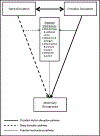Sleep and circadian disruption and incident breast cancer risk: An evidence-based and theoretical review
- PMID: 29032088
- PMCID: PMC6025900
- DOI: 10.1016/j.neubiorev.2017.10.011
Sleep and circadian disruption and incident breast cancer risk: An evidence-based and theoretical review
Abstract
Opportunities for restorative sleep and optimal sleep-wake schedules are becoming luxuries in industrialized cultures, yet accumulating research has revealed multiple adverse health effects of disruptions in sleep and circadian rhythms, including increased risk of breast cancer. The literature on breast cancer risk has focused largely on adverse effects of night shift work and exposure to light at night (LAN), without considering potential effects of associated sleep disruptions. As it stands, studies on breast cancer risk have not considered the impact of both sleep and circadian disruption, and the possible interaction of the two through bidirectional pathways, on breast cancer risk in the population at large. We review and synthesize this literature, including: 1) studies of circadian disruption and incident breast cancer; 2) evidence for bidirectional interactions between sleep and circadian systems; 3) studies of sleep and incident breast cancer; and 4) potential mechanistic pathways by which interrelated sleep and circadian disruption may contribute to the etiology of breast cancer.
Keywords: Breast cancer; Cancer; Circadian disruption; Circadian rhythms; LAN; Light at night; Mammary oncogenesis; Night shift work; Sleep; Sleep disruption; Sleep duration.
Copyright © 2017. Published by Elsevier Ltd.
Conflict of interest statement
Conflict of interest
The authors attest that they have no conflicts of interest.
Figures
References
-
- Abedin MJ, Wang D, McDonnell MA, Lehmann U, Kelekar A, 2007. Autophagy delays apoptotic death in breast cancer cells following DNA damage. Cell Death Differ. 14 (March), 500–510. - PubMed
-
- Adami HO, Signorello LB, Trichopoulos D, 1998. Towards an understanding of breast cancer etiology. Semin. Cancer Biol. 8 (August), 255–262. - PubMed
-
- Anisimov VN, 1971. Blastomogenesis in rats with persistent estrus. Vopr. Onkol. 17, 67–75. - PubMed
-
- Anisimov VN, 2003. The role of pineal gland in breast cancer development. Crit. Rev. Oncol. Hematol 46 (June), 221–234. - PubMed
Publication types
MeSH terms
Grants and funding
LinkOut - more resources
Full Text Sources
Other Literature Sources
Medical
Research Materials



